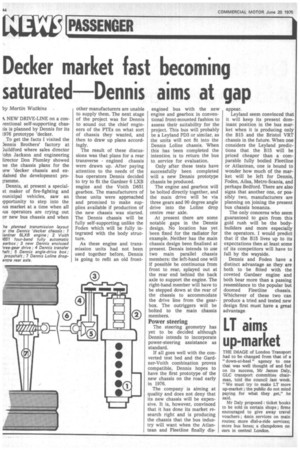Decker market fast becoming saturated Dennis aims at gap
Page 46

If you've noticed an error in this article please click here to report it so we can fix it.
by Martin Watkins ti NEW DRIVE-LINE on a conrentional self-supporting chas;is is planned by Dennis for its [976 prototype 'decker.
To get the facts I visited the )ennis Brothers' factory at 3uildford where sales director 'ohn Jackson and engineering lirector Don Plumley showed ne the chassis plans for the iew 'decker chassis and exilained the development pro;ramme.
Dennis, at present a specialst maker of fire-fighting and nunicipal vehicles, saw an pportunity to step into the 'us market at a time when all Qs operators are crying out or new bus chassis and when other manufacturers are unable to supply them. The next stage of the project was for Dennis to sound out the chief engineers of the PTEs on what sort of chassis they wanted, and then to draw up plans accordingly.
The result of these discussions was that plans for a rear transverse engined chassis were drawn up. After paying attention to the needs of the bus operators Dennis decided to try to fit the Gardner 6 LXB engine and the Vaith D851 gearbox. The manufacturers of these units were approached and promised to make supplies available if production of the new chassis was started. The Dennis chassis will be fully self-supporting unlike the Foden which will be fully integrated with the body structure.
As these engine and transmission units had not been used together before, Dennis is going to refit an old front engined bus with the new engine and gearbox in conventional front-mounted fashion to assess their suitability for the project. This bus will probably be a Leyland PD3 or similar, as the units will not fit into the Dennis Loline chassis. When this has been completed the intention is to return the bus to service for evaluation.
Only after these tests have successfully been completed will a new Dennis prototype chassis be produced.
The engine and gearbox will be bolted directly together, and the main drive will be via three gears and 90 degree angle drive into the Loline drop centre rear axle.
At present there are some notable gaps in the Dennis design. No location has yet been fixed for the radiator for example. Neither has the main chassis design been finalised at present. Dennis intends to use two main parallel chassis members: the left-hand one will if possible be continuous from front to rear, splayed out at the rear end behind the back axle to support the engine. The right-hand member will have to be stepped down at the rear of the chassis to accommodate the drive line from the gearbox. The outriggers will be bolted to the main chassis members.
Power steering
The steering geometry has yet to be decided although Dennis intends to incorporate power-steering assistance as standard.
If all goes well with the converted test bed and the Gardner-Voith combination proves compatible, Dennis hopes to have the first prototype of the new chassis on the road early in 1976.
The company is aiming at quality and does not deny that its new chassis will be expensive. It is, however, convinced that it has done its market research right and is producing the chassis that the bus industry will want when the Atlantean and Fleetline finally dis appear.
Leyland seem convinced that it will keep its present dominant position in the bus market when it is producing only the B15 and the Bristol VRT chassis in the future. When one considers the Leyland predictions that the 1115 will be priced cheaper than a comparable fully bodied Fleetline or Atlantean, one is bound to wonder how much of the market will be left for Dennis, Foden, Ailsa, Metro-Scania, and perhaps Bedford. There are also signs that another one, or possibly two, manufacturers are planning on joining the present bus chassis bonanza.
The only concerns who seem guaranteed to gain from this gold rush will be the bodybuilders and more especially the operators. I would predict that if the B15 lives up to its expectations then at least some of its competitors will have to fall by the wayside.
Dennis and Foden have a distinct advantage as they are both to be fitted with the coveted Gardner engine and both bear more than a passing resemblance to the popular but doomed Fleetline chassis. Whichever of these two can produce a tried and tested new design first must have a great advantage




























































































































































